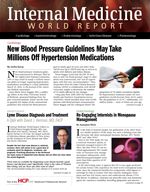Publication
Article
Internal Medicine World Report
Normalizing Blood Pressure May Prevent a Second Stroke
Author(s):
Although many clinicians presumed patients with poor collateral blood vessel formation near their stroke site should have their blood pressure left high to prevent a second stroke, a study published in Neurology found lowering blood pressure to normal levels reduces subsequent stroke risk more effectively.

Although many clinicians presumed patients with poor collateral blood vessel formation near their stroke site should have their blood pressure left high to prevent a second stroke, a study published in the March 26, 2014, issue of Neurology found lowering blood pressure to normal levels reduces subsequent stroke risk more effectively.
According to William Powers, MD, of the Department of Neurology at the University of North Carolina School of Medicine, neurologists had long suspected that keeping a stroke patient’s blood pressure high might force blood around the blockage and through collateral blood vessels, which would thus reduce stroke risk. However, Powers and his co-authors found evidence that allowing blood pressure to remain high in those patients can lead to a 4-fold increase in their risk of stroke.
“We have very good studies showing that normalizing blood pressure works, but some doctors argue that reducing blood pressure in patients with poor collaterals would be dangerous,” Powers said in a press release. “Up until now, doctors would say to patients, ‘Well, we think you should do this or we think you should do that.’ But our paper provides the first data that show how patients with poor collateral vessels should be treated.”
Using data from positron emission tomography (PET) scans of 91 stroke patients with poor collateral blood flow, Powers found 40 of them had an average blood pressure of <130/85 mm Hg during the first 2 years after their stroke, while the remaining 51 had blood pressures above that level, which indicated hypertension. Only 3 of the 40 patients with normal blood pressure had a second stroke, whereas 10 of the 51 patients with hypertension suffered a second stroke.
Therefore, the study authors concluded that lowering blood pressure to normal levels reduced the risk of a second stroke by 22% — a finding Andrew Southerland, MD, a neurologist at the University of Virginia who was not involved in the study, called “a huge absolute risk reduction that we don’t often see in this field,” which he noted “clears up a murky question about how to manage blood pressure in these patients.”
“The idea that you should let blood pressure ride high to prevent a second stroke in these patients turns out to be completely wrong,” Powell concluded. “You should treat their blood pressure just like you should treat everybody else who had a stroke to reduce the risk of a second one.”
The study was supported by grants through the National Institute of Neurological Disorders and Stroke (NINDS).






